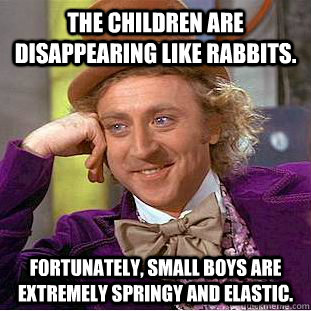On Bullies
First, some history (and context!) from Laine…
I was overweight as a kid. Actually, I was overweight until I was in my mid-twenties, and then again for a while after I had my kids. But as a kid, in the 90s, it was an offense punishable by social ostracization. I was picked on throughout elementary school, to the point where I started calling myself fat so that other people wouldn’t do it first.
I moved at the end of 6th grade, to a much larger school. They mostly didn’t bully me for being overweight, but they did bully me for making out with my (female) best friend – which I did not, not that that matters aside from pissing me off even MORE about the sheer unfairness of it. I moved again at the end of 8th grade, to a smaller school, and found friends, and slipped into blessed nerd + “I’m in the school musical every year” semi-obscurity.
I dealt with one bully as a young adult, after I started my first job. I can see, looking back on it, that he probably felt threatened because, a) I was good at my job, b) I was on “his” project, and c) he perhaps felt like I was overstepping.
And then…no bullies. For a long time.
And then…more bullies showed up.
We’ve written about pieces of what happened at the church we were both members of. We have not written about what happened where we were formerly employed, out of (probably legitimate) fear of retaliation of some kind. But…suffice it to say that we’ve both run into a lot of bullies over the past few years. People we worked with, people we trusted. People we loved.
We try to explain a lot of patterns here. Patterns about fear and faith and hope and love, and how all of that comes together and applies to being a person. Patterns about how all of that scales to relationships (especially with God), and how it scales to and for organizations. A lot of these patterns, we figured out because…we lived them. We ran into really scared people trying to control what we did – and getting very very angry when we said no. That’s it. Just… no. We didn’t say, “you have to do what I say,” or “I’m going to make your life miserable for trying to tell me what to do.” Mostly we said, “please stop hurting us,” and “why are you trying to make me do something that I am sure is wrong?” and then eventually, just… no.
Sometimes “no” is a revolutionary act.
Decisions must be made…
Laine initially drafted this post in September of 2020. That’s actually the opposite of our usual process, typically we talk about things until it seems draft-able, then Josh does the initial draft. But this post began because Laine ran into a (comparatively mild) bully at work. And it brought back a lot of feelings about the other bullies we’ve recently run into, and a lot of sheer…exhaustion.
And then the election happened, and that brought with it more related feelings, and more exhaustion. And both the minor work bully and the election brought with them some clarity around what happens with bullies.
Bully (n): someone who does willful, targeted damage to other people in an effort to control them.
Because…bullies seem to win. The world actually seems to be structured for bullies – and for the control of other people. If you choose not to control other people, if you don’t play that game, if you flat-out refuse to play that game, then…you are an outlier. You stand out. You seem to invite bullies to take shots at you. But…that isn’t quite what happens.
Simply by existing, by living your life without controlling other people, you show the people around you that they too could choose not to control. You demonstrate, clearly, that another choice, a different choice, exists. This has the effect of forcing the bullies around you to choose if they will continue to bully – because some people behave this way because they don’t know another choice exists.
Bullies also force you to make a choice. Bullies force you to choose if you’re going to a) hide who you are in order to avoid the damage they might do, or b) very deliberately NOT hide, but instead choose that any damage is worth being yourself. As best as we’ve been able to figure out, bullies bully because they’re afraid they’re going to lose something that they think keeps them safe. Bullies need to control what they think keeps them safe so much that the people “in the way” become…dispensable.
So…if you’re the target of a bully, if you feel like your very existence invites bullies to take shots at you, then…that means that you’ve stumbled into the thing that they’re trying to hide away from the world – the thing they’re afraid they’ll lose. And it means that they don’t much like the fact that people exist who can’t be controlled into supporting their fears, and it means that they’re afraid that perhaps none of it was necessary at all.
It’s not your fault.
We’re going to say that one more time. It’s not. your. fault. We are emphasizing this because, again, it took us a long time to understand and accept it.
Mostly, with this post, we wanted to make something very clear – adult bullies exist. They exist anywhere that people exist, because people get scared, and sometimes those scared people end up with some kind of authority – real or imagined – over you and your life. This can be your boss, or your religious leader, or your government, or your significant other. Sometimes these people get SO scared that they forget entirely that you’re a person, and they just…want you to stop whatever you’re doing that seems to be a threat to them.
Regardless of what they say, it isn’t your fault. Bullies will tell you that it is, because they’re trying to convince you to change, and to hide, so that they feel more safe. You don’t have to do that. It’s scary not to, but…it is your choice. You can say no, and you can choose to be who you really are even if the bullies of the world don’t like it.
Sometimes “no” is a revolutionary act.
You won’t be alone.
The more we sort of…lean into this plan, the “be you and have fun” plan, the more we find other people who have figured this out. These people are some of the most truly supportive relationships that we have. So…while saying no to the bullies in your life, and choosing to be yourself, seems scary and like you’ll definitely be alone… you won’t. You will find your tribe, your people, your chosen family, and you will thrive. It’s worth it.





 So…remember science?
So…remember science?
 There’s something wrong with the world today,
There’s something wrong with the world today,




